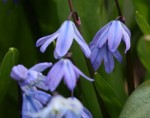 By the beginning of June the bulb catalogs start rolling in. It seems a bit early to be thinking of bulbs for next spring especially when the foliage from my narcissus this spring has not disappeared. Ah…but that is a good thing. I can look around and with the help of my garden journal (now full of pictures on my computer) I can visualize what I will need to make my garden look better next year. Orders can be placed any time until fall but if you get the order in early you will probably get all the items you want. Yes, popular bulbs sell out and I have missed some good ones when I have dilly-dallied around with my bulb order.
By the beginning of June the bulb catalogs start rolling in. It seems a bit early to be thinking of bulbs for next spring especially when the foliage from my narcissus this spring has not disappeared. Ah…but that is a good thing. I can look around and with the help of my garden journal (now full of pictures on my computer) I can visualize what I will need to make my garden look better next year. Orders can be placed any time until fall but if you get the order in early you will probably get all the items you want. Yes, popular bulbs sell out and I have missed some good ones when I have dilly-dallied around with my bulb order.
There are many good bulb dealers on line. Check out Garden Watchdog on davesgarden.com; it gives customers comments and ratings on many different ones. The ones I have checked out get their bulbs from Holland in the fall and ship them too you at the correct planting time. I have had good success with Van Engelen Inc. and Scheepers (Van Engelen’s retail branch) in Connecticut, and Brent and Becky’s in Virginia. Van Engelen is a wholesaler and so you have to buy large quantities but the savings are substantial. They all have a huge selection of bulbs and will all send you a catalogue on request and then a yearly one after that if you make a purchase. Van Engelen’s catalogue has a few sketches of flowers but Scheepers has full color pictures of every kind of bulb, so order a catalogue from both. Please note, I have not received any free products from any of these companies and am recommending them solely on my experience with them. Check them out on the Garden Watchdog.
The entries for narcissus and tulips are usually the largest. I’ll begin with them because they are the most familiar and then go to other groups that most people will recognize. I’ll touch on some very early ones that have confusing names but are familiar, and some that are more exotic and less familiar. Most good companies will carry these, and even more, but this overview will give you an idea of what is possible.
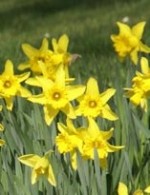 Narcissus /Daffodil (Narcissus spp.)
Narcissus /Daffodil (Narcissus spp.)
There are more than 25,000 kinds of narcissus if you count all the different cultivars that have been developed. Narcissus differ in many ways including height, color, shape, bloom time, fragrance, tendency to naturalize, and size of flower. Where you live as well as your personal preferences make a difference when selecting the right narcissus. No one company is going to offer all 25,000 narcissus or even close to it, but companies like the ones I suggested above will give you a wide selection of the best varieties. For more on this see my post on selecting narcissus.
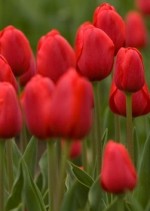 Tulip (Tulipa spp.)
Tulip (Tulipa spp.)
Tulips are not as numerous as narcissus; there are a mere 3,000 different kinds. They differ in many ways including color, height, bloom time, size and shape of flower, fragrance, appearance of the foliage, ability to return each year, and usefulness in garden or home. Most catalogs offer you more different kinds of tulips that you have probably ever seen before! To help you pick some favorites see my post on selecting tulips.
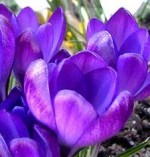 Crocus (Crocus spp.)
Crocus (Crocus spp.)
Another favorite group consists of spring blooming crocuses. There are two major divisions, the species crocus, and the large flowering crocus. Before you decide on the bigger flowers keep in mind that these plants with bigger flowers have bigger leaves and you should consider how much patience you have with the crocus foliage before choosing. There are other considerations too, like, time of bloom. The species crocus bloom two weeks earlier than the large flowering kinds. Both kinds of crocus come in various shades of blue, purple, yellow, and white, are deer resistant, and are good for forcing. And by the way, there are also fall blooming crocuses and autumn crocuses (actually a Colchicum).
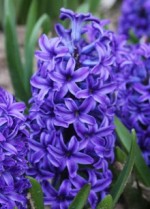 Hyacinths (Hyacinthus orientalis)
Hyacinths (Hyacinthus orientalis)
For fragrance, you can’t beat old fashioned hyacinths. They have a stiff, stuffy look and don’t come back faithfully every year but they have a certain charm that no other spring bulb has. They are especially useful for bedding-out in geometric designs or forcing. Hyacinths vary in several ways including color, number of petals per flower and number of stems per bulb. They come in pink, rose, white, peach, yellow and various shades of lavender/blue. For more information on selecting hyacinths see read my post on hyacinth selection.
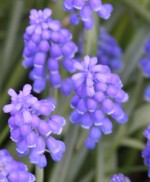 Grape hyacinths (Muscari spp.)
Grape hyacinths (Muscari spp.)
Grape hyacinths bear spikes of small, long lasting flowers that have a sweet grape-like fragrance. Most have bell shaped flowers tightly clustered on upright stems but one appears to have tassels while another has feathery plumes. Color is usually white, pink, or shades of blue, but one is yellow. They look as natural in a woodland as they do along the border of a formal bed, are deer resistant and naturalize well.
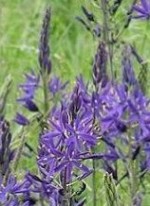 Wild Hyacinth (Camassia spp.)
Wild Hyacinth (Camassia spp.)
Wild hyacinth also known as Quamash, belongs to the genus Camassia. It bears star-shaped flowers that open from the bottom up on 24-30” stems. Flowers are white and various shades of blue; foliage is upright and sword-like. Unlike many other bulbs, it likes moist soil and tolerates heavy clay soils.
 Spanish and English Bluebells (Hyacinthoides spp.)
Spanish and English Bluebells (Hyacinthoides spp.)
Previously classified as Scilla, Spanish and English bluebells have small bell-shaped flowers in pink, white or blue, similar to those of the old fashioned hyacinth, H. orientalis discussed above. Instead of being tightly packed, however, they are loose and pendant. The plants thrive in moist soil and naturalize well.
Iris come in many forms and some are bulbs
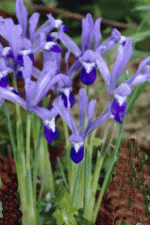 Rock Garden Iris
Rock Garden Iris
The so called rock garden iris, or dwarf iris, include early blooming ones mostly from the species danfordiae and reticulata. They are about 4” tall when they bloom and produce 12” grass like foliage when the flowers fade but it is so fine and wispy that it is not a problem. Flowers come in shades of yellow, white, lavender and various shades of blue with many flowers having falls and standards in different colors or shades of the same color.
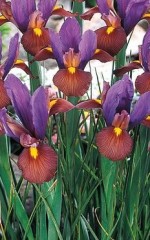 Dutch iris
Dutch iris
Hybrids of a 16th century Spanish species, Dutch iris have light, airy flowers borne in late spring. The flowers are in shades of yellow, white, and blue and often have falls and standards of different colors. They are very attractive in the garden as well as in arrangements, lasting a bit longer in the vase than other iris.
The catalogs usually have a number of bulbs that are not familiar and therefore easy to confuse. Here are some that you are most likely to see.
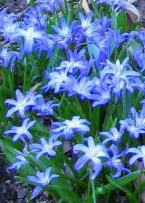 Glory of the Snow (Chionodoxa spp.)
Glory of the Snow (Chionodoxa spp.)
In late winter or early spring, single sprays of blue, pink, lavender or white starry flowers make their appearance. They naturalize well in rock or woodland gardens and can be forced for indoor enjoyment.
For additional information see the Glory of the Snow Plant Profile .

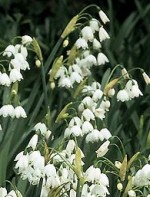 Summer Snowflake (Leucojum aestivum)
Summer Snowflake (Leucojum aestivum)
Clusters of white bell-shaped flowers tipped with green hang from slender stalks 18-24” tall among grass like leaves. Tolerant of moist soils. Naturalizes well with daffodils. Most catalogs offer the species as well as a larger cultivar that resembles lily of the valley.

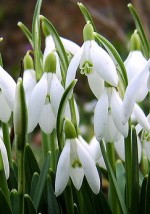 Snowdrop (Galanthus spp.)
Snowdrop (Galanthus spp.)
Small bell-shaped white flowers often tipped with green nod on slender stems above narrow, linear foliage. Species vary in the amount of green in the flower, the number of petals, and leaf appearance but all are otherwise similar. In some areas they will start blooming in the fall and continue until spring. Grow best in partial shade and moist soil. For additional information see the Snowdrop Plant Profile.
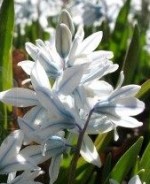 Striped Squill (Puschkinia scilliodes
Striped Squill (Puschkinia scilliodes
With many starry flowers clustered at the tops of stems, this relative of Glory of the Snow and Wood squill is an heirloom bulb, good for naturalizing in drifts, border plantings, rock gardens and forced pots. Two varieties are commonly offered, one blue the other white.
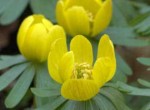 Winter Aconite (Eranthis hyemalis)
Winter Aconite (Eranthis hyemalis)
In contrast to the many spring blooming bulbs with white, pink, or blue bell-shaped flowers, this diminutive plant stand out. The lemon yellow flowers are surrounded by a finely divided recurved calyx and open wide like little buttercups. Plants like rich moist soil in partial shade. For additional information see the Winter Aconite Plant Profile.
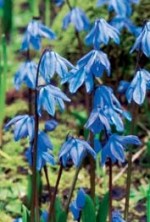 Wood Squill (Scilla spp.)
Wood Squill (Scilla spp.)
Give wood squill dappled shade and it will thrive. Scillas have starry flowers and strap-like leaves but vary in height, bloom time and color with white, blue, pink and violet selections. For additional information see the Siberian Squill Plant Profile.

These last three offer something spectacular.
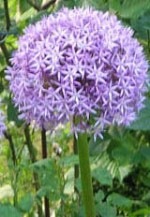 Ornamental Onion (Allium spp.)
Ornamental Onion (Allium spp.)
Perhaps these should not be included in a post on spring blooming bulbs because many of them are summer blooming. There are several, however, that bloom in the spring and have the “WOW factor”. To get an idea of the flower heads, think about the flowers of chives, the herb that combines with sour cream in baked potatoes. Then think about a flower head that has the same globular shape but is as big as a bowling ball. There are alliums with flower heads in all sorts of sizes, carried on different sized stems, blooming at different times…you get the picture. Check them out, they are a real garden treat.
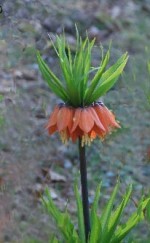
Like the odor of skunks? Check out these plants that have a skunky ordor. They are also relatively difficult to grow but their exotic look is worth the trouble. The Guinea Hen flowers (F. meleagris) is perhaps the humblest, while the Crown Imperial (F. imperialis) commands the most attention. Fritillaries like rich, well drained soil. Guaranteed to get complements. For additional information see the Crown Imperial Plant Profile.

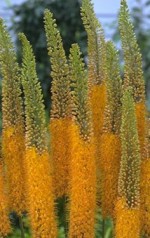 Foxtail lilies (Eremurus spp.)
Foxtail lilies (Eremurus spp.)
Here’s another knock-out especially for those with a very green thumb. The densely packed flowers are borne on tall, willowy spires, and open progressively from the bottom to top. Give them rich, well-drained soil, in full sun in a protected spot and with luck you will have a spectacular plant in late spring.
Most catalogs will offer dozens of other plants that you have no or only a slight acquaintance with but trying new plants is what makes gardening dynamic. Try some old stand-bys and then branch out to experience something new and different. Not all bulbs come back each year so many mistakes will disappear. Many of the smaller bulbs are very inexpensive if you buy them in quantity so get together with a gardener friend and split an order of new-to-you bulbs. Interesting and fun, that’s what gardening is all about.
